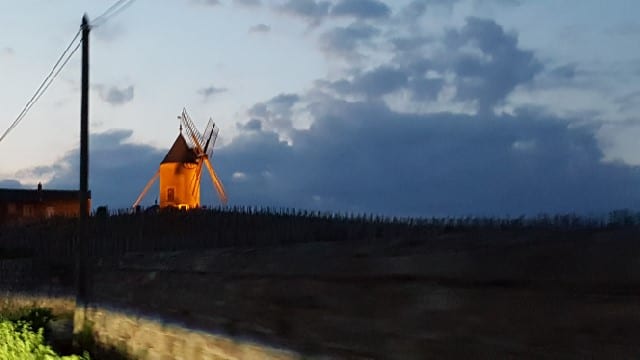

07 Sep A Windmill and Wine at Chateau Moulin-à-Vent
This story originally appeared in the Napa Valley Register.The sun was setting as we drove to our dinner at Chateau Moulin-à-Vent. It was my first time to Beaujolais, and as we turned up the road to our destination, we saw, sitting on the top of the hill in front of us, the iconic Moulin-à-Vent, or windmill.


The 500-year-old structure was breathtaking as the sky turned from a light yellow to a warm orange. After a few photos, we drove 650 feet farther and arrived at Chateau Moulin-à-Vent.
Moulin-à-Vent, located in the southernmost tip of Burgundy, is one of the 10 Crus of Beaujolais. Moulin-à-Vent borders the vineyards of Chenas to the north and Fleurie to the south.


Declared AOC status in 1936, Moulin-à-Vent, named for that windmill on the hill, lies on the slopes of the Beaujolais hills. There are 650 hectares of vines in Moulin-à-Vent and more than 60 different micro-terroirs. The soils range from sandy to pink granite. Due to the mineral manganese found in the soils, which is toxic to grapevines, the yields in Moulin-à-Vent are smaller with highly concentrated grapes. There are a lot of sunlight hours and a lot of wind, a defining characteristic of the region, and hence the windmill.


Bearing the same name as the region, Chateau Moulin-à-Vent, originally named Chateau des Thorins, began in the 1700s. Under the same family ownership from 1911 to 2009, Chateau Moulin-à-Vent was purchased by Jean-Jacques Parinet and his son Edouard in 2009. At the time, the vines were not healthy and the chateau was quite basic. They replanted the vineyards first and then upgraded the chateau and modernized the winery in the cellar, the most ancient part of the winery dating to the 16th and 17th centuries.




Chateau Moulin-à-Vent owns 30 hectares (91.4 acres) of gamay, averaging 40 years in age, in top vineyard sites across the appellation. The grapes are harvested by hand, isolated into 130 small plots. Some plots are whole cluster and some are destemmed.
Beaujolais is a region traditionally associated with carbonic maceration, the process of fermenting whole bunches of grapes with carbon dioxide, which results in the fruity style the region is known for. According to Chateau Moulin-à-Vent winemaker Brice Laffond, the use of carbonic maceration varies from winery to winery and at Chateau Moulin-à-Vent they chose not to use it. Instead they are focused on the terroirs within their vineyards and in general prefer long extractions in taller tanks with thicker, shorter caps.
Forget the fresh, fruity Beaujolais Nouveau. The wines of Chateau Moulin-à-Vent can rival the pinot noir of Burgundy. Compared to Fleurie to the south, which offers a more elegant, floral style wine, Moulin-à-Vent wines are more structured and complex.


Chateau Moulin-à-Vent Couvent des Thorins 2015 – The brightest and freshest of the lineup, this is an easy wine to drink with aromas of red and purple fruits and mineral notes on the finish.
Chateau Moulin-à-Vent, Moulin-à-Vent 2014 – A blend of grapes from Les Thorins, Les Caves, Le Moulin-à-Vent, La Rochelle and La Roche, the wine has aromas of dark cherry, plum and white pepper with medium acidity.
Chateau Moulin-à-Vent Croix Des Verillats 2014 – Named after a Redemption Cross in the center of this vineyard, the thin granitic soils and wind exposure create a sexy, rustic wine with aromas of wild berries, licorice and minerality.
Chateau Moulin-à-Vent Champ de Couer 2014 – Located on a plateau between the hills of the windmill and of Fleurie, the grapes are grown in soils of clay and granite, resulting in a wine with mineral and dark cherry notes and a full-palate acidity.
Chateau Moulin-à-Vent La Rochelle 2014 – The La Rochelle vineyard is located on a slope under the Champ de Couer vineyard on the top of the hill. The old vines in sandy granite with clay underneath produce a dense, but bright, wine with dark red and purple fruit.
Chateau Moulin-à-Vent Clos de Londres 2011 – Clos de Londres is the vineyard that stretches from the chateau to the windmill. With aromas of ripe raspberry, violet and a savory note, this gamay could easily be mistaken for a pinot noir.
As dinner ended and we were enjoying a final glass of wine, Edouard asked if we wanted to walk to the windmill and see it at night. It was past midnight but how could I pass up this once-in-a-lifetime experience? We walked outside into the dark of night, turning on the flashlights of our cellphones. Stepping on the uneven terrain, my eyes were focused on the ground, hoping not to fall in one of the many holes or trip over one of the large rocks. After a 10-minute walk across the Clos de Londres, I looked up and there it was, lit up against the black sky, the magnificent, well-preserved windmill, the icon of Moulin-à-Vent.


Discover more from Please The Palate
Subscribe to get the latest posts sent to your email.


